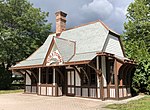Monument to First Rhode Island Regiment
1982 establishments in New York (state)African-American history of New York (state)African-American history of Westchester County, New YorkAfrican-American military monuments and memorialsAfrican diaspora ... and 4 more
Cultural heritage of the United StatesHistoric trails and roads in New York (state)Tourist attractions in Westchester County, New YorkYorktown, New York

The Monument to the 1st Rhode Island Regiment at Yorktown Heights, New York was erected on May 13, 1982 on the grounds of the First Presbyterian Church to commemorate the valiant efforts of a Revolutionary War unit composed predominantly of black soldiers that fought on May 14, 1781 under the command of Colonel Christopher Greene.
Excerpt from the Wikipedia article Monument to First Rhode Island Regiment (License: CC BY-SA 3.0, Authors, Images).Monument to First Rhode Island Regiment
Crompond Road,
Geographical coordinates (GPS) Address Nearby Places Show on map
Geographical coordinates (GPS)
| Latitude | Longitude |
|---|---|
| N 41.294233333333 ° | E -73.80885 ° |
Address
First Presbyterian Church
Crompond Road 2880
10598
New York, United States
Open on Google Maps






